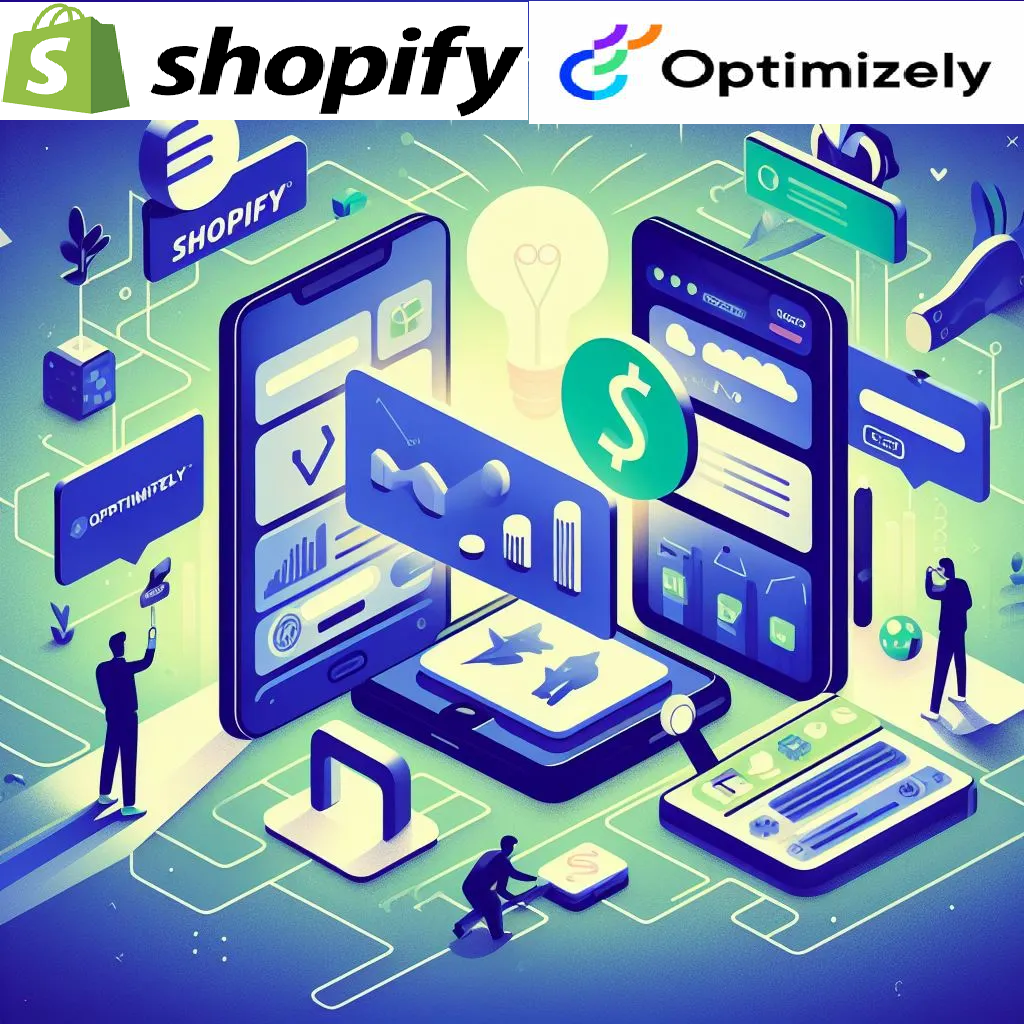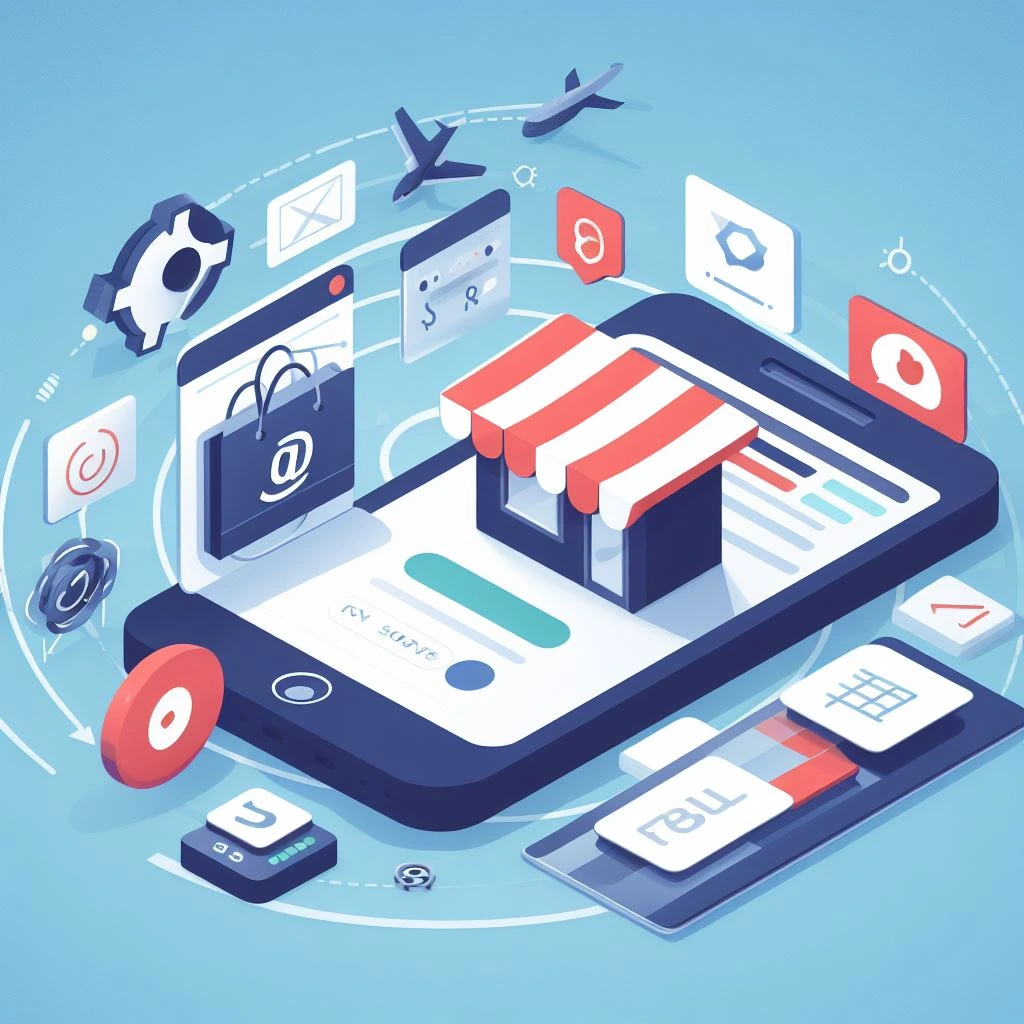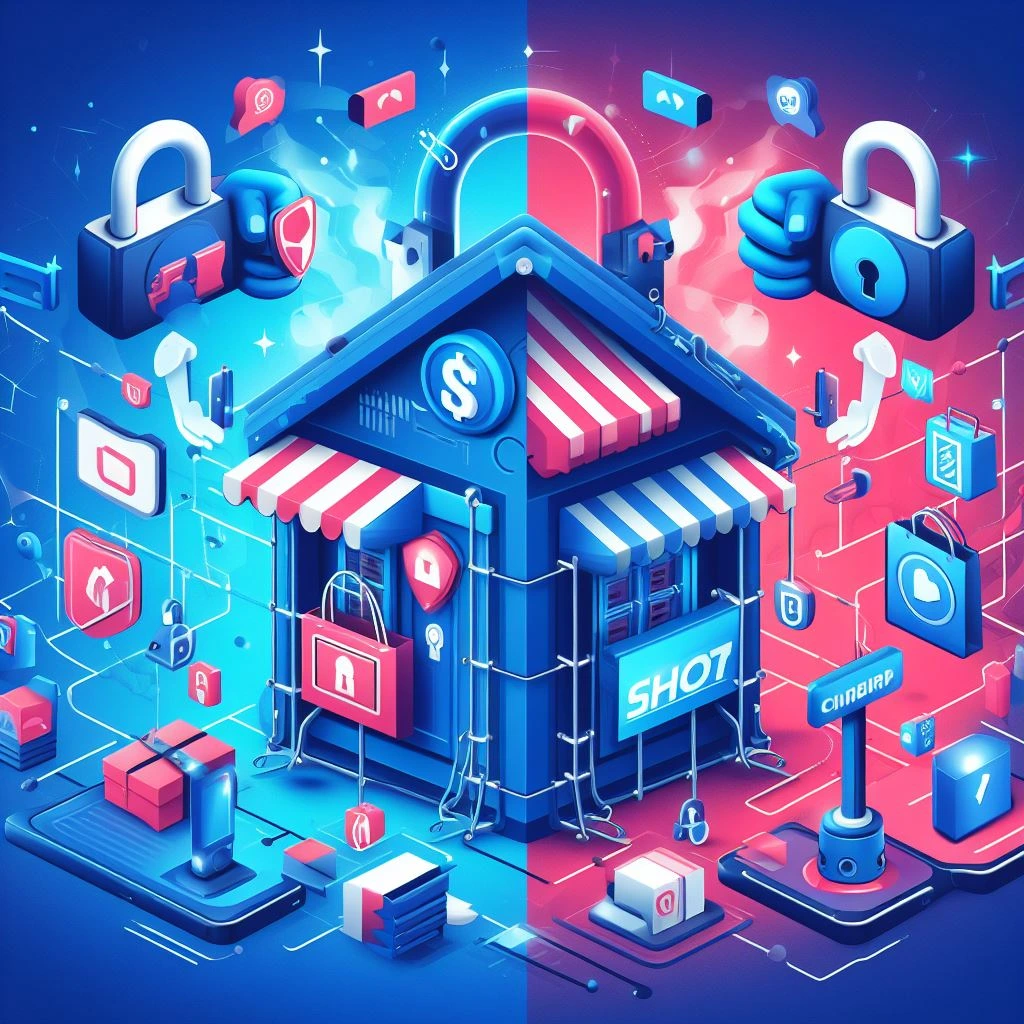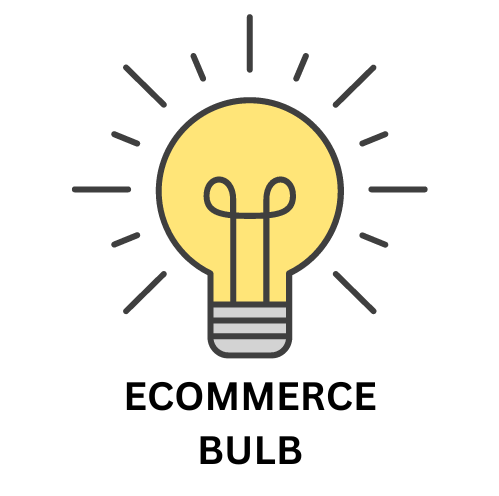
Optimizely Vs. Shopify? Which is Better eCommerce Platform?
In order to decide which ecommerce platform to use, Shopify vs. Optimizely. A detailed comparison between features must be thoroughly done. If you want to decide which eCommerce platform to choose, there are many things to consider.
These are some examples of these factors:
- Cost.
- SEO friendliness.
- Page load speed.
- Canonical website URL.
- Indexing Control.
- Customizable HTML capabilities.
- Sitemap Generator.
- Integration with Google Analytics.
- Product Tagging and Categorization.
- Batch Uploading.
- Mobile Optimization.
- Built-in Blogging and Marketing Features.
- Social Sharing Buttons.
- Content Management Capabilities.
- Discount and promotion code tools.
- Easy to use Checkout.
- Reporting tools and custom reports.
- Integration of email marketing tools.
- Multiple payment options.
- Flexibility to add new eCommerce features.
- Exclusive features.
- Cons and pros.
Here we’ll discuss these factors to help you decide which platform is better for you, Optimizely or Shopify. And at the end of the discussion, we’ll recap and make a comparison for the scores of all these points to find out which eCommerce platform has the higher score, so that you’ll have a good view about both of them.
Pricing (Shopify Vs. Optimizely):

Pricing Comparison: Shopify vs. Optimizely
Both Shopify and Optimizely offer a variety of pricing plans to suit different business needs and sizes. However, Shopify generally provides more affordable pricing options for smaller businesses, while Optimizely’s pricing is more tailored to larger enterprises with more complex requirements.
Shopify Pricing
Shopify offers four main pricing plans:
- Basic Shopify: $29 per month
- Shopify: $79 per month
- Advanced Shopify: $299 per month
- Shopify Plus: Custom pricing
Each plan includes different features and transaction limits. For example, the Basic Shopify plan is suitable for small businesses with limited product catalogs and sales volume, while the Shopify Plus plan is designed for large enterprises with high-volume transactions and sophisticated marketing needs.
Optimizely Pricing
Optimizely offers a custom pricing model based on your business needs and usage. The company provides a variety of pricing tiers, including:
- Core: For businesses starting with experimentation
- Growth: For businesses scaling experimentation efforts
- Enterprise: For large enterprises with complex experimentation needs
Optimizely’s pricing typically starts at around $5,000 per month and can scale up to tens of thousands of dollars per month for large enterprises.
Overall Pricing Comparison
Based on the standard pricing plans, Shopify generally offers more affordable options for smaller businesses. However, Optimizely’s pricing is more flexible and can be tailored to the specific needs of larger enterprises.
Here’s a table summarizing the key pricing differences between Shopify and Optimizely:
| Feature | Shopify | Optimizely |
|---|---|---|
| Pricing model | Subscription-based with four main plans | Custom pricing based on business needs |
| Starting price | $29 per month | $5,000 per month |
| Target audience | Small to medium-sized businesses | Large enterprises |
| Scalability | Scalable to accommodate growth | Highly scalable for complex enterprise needs |
Conclusion
The best pricing option for you will depend on the size and complexity of your business. If you are a small business with limited needs, Shopify’s affordable pricing plans may be a good fit. However, if you are a large enterprise with complex experimentation requirements, Optimizely’s custom pricing model can be tailored to your specific needs.
SEO Capabilities (Shopify Vs. Optimizely):

Both Shopify and Optimizely offer a range of SEO features to help you optimize your online store for search engines. However, Shopify generally provides more comprehensive and user-friendly SEO tools, making it a better choice for businesses that prioritize search engine optimization.
Shopify SEO Features
Shopify offers a built-in SEO suite that includes:
- SEO-friendly URLs: Customizable URLs with relevant keywords
- Meta tags: Editable meta titles and descriptions for each page
- Image alt tags: Alt tags for product images to improve image search rankings
- Structured data markup: Rich snippets to enhance search results
- Site speed optimization: Fast loading times to improve user experience and search engine rankings
- SEO app ecosystem: Extensive selection of third-party SEO apps for advanced optimization
Optimizely SEO Features
Optimizely offers a limited set of built-in SEO features, but it does integrate with various third-party SEO tools to provide more comprehensive capabilities. These integrations include:
- Search Console: Access to Google Search Console data within Optimizely
- A/B testing for SEO: Experiment with different SEO strategies to optimize your site
- Personalization for SEO: Personalize content and experiences based on user behavior and preferences
Comparison Summary
| Feature | Shopify | Optimizely |
|---|---|---|
| Built-in SEO tools | Comprehensive and user-friendly built-in SEO suite | Limited built-in SEO tools |
| Third-party SEO integrations | Extensive selection of SEO apps | Integrations with various SEO tools |
| Approach to SEO | Focus on on-page optimization and technical SEO | Focus on personalization and experimentation for SEO |
| Overall SEO capabilities | More comprehensive and user-friendly SEO capabilities | Limited built-in SEO capabilities but enhanced with third-party integrations |
Conclusion
If you prioritize search engine optimization and want a user-friendly platform with built-in SEO tools, Shopify is generally the better choice. Its comprehensive SEO suite, extensive app ecosystem, and focus on on-page optimization make it a powerful tool for improving your store’s search engine visibility.
Read More: Shift4shop Vs. Shopify, The Complete Comparison to Help you Decide.
PageLoad Speed (Shopify Vs. Optimizely):

Page Load Speed Comparison: Shopify vs. Optimizely
Page load speed is a crucial factor for both user experience and search engine optimization (SEO). Faster page load speeds lead to better user engagement, higher conversion rates, and improved search rankings.
Both Shopify and Optimizely offer features and tools to optimize page load speed, but Shopify generally provides a more comprehensive approach to page speed optimization and consistently delivers faster loading times.
Shopify Page Load Speed
Shopify offers a built-in suite of page speed optimization tools, including:
- Image optimization: Automatically compresses images without compromising quality
- Theme optimization: Efficient theme coding and design principles
- CDN integration: Integration with content delivery networks (CDNs) for faster global delivery
- Third-party optimization apps: Extensive selection of apps for further optimization
Optimizely Page Load Speed
Optimizely provides tools for experimentation and personalization, but it doesn’t have a dedicated page speed optimization suite. However, it offers integrations with third-party tools that can help improve page load speed.
Page Load Speed Benchmarks
According to various page load speed benchmarks, Shopify consistently outperforms Optimizely in terms of loading times. Shopify’s median page load time is typically around 2.5 seconds, while Optimizely’s median page load time is around 3.5 seconds.
Factors Affecting Page Load Speed
It’s important to note that page load speed can be influenced by various factors beyond the eCommerce platform, such as website design, hosting provider, and third-party integrations. However, Shopify’s built-in optimization tools and overall performance generally lead to faster loading times.
Conclusion
If page load speed is a priority for your eCommerce business, Shopify is generally the better choice. Its comprehensive optimization tools, CDN integration, and consistent faster loading times can significantly improve user experience, conversion rates, and SEO performance.
While Optimizely offers personalization and experimentation features, its page speed optimization capabilities are less robust. If you already use Optimizely for other marketing initiatives and are willing to utilize third-party tools for page speed optimization, it can still be a viable option.
Read More: Sellfy Vs. Shopify, Which is the Better eCommerce Platforms for my Needs?
Canonical Website URL (Optimizely Vs. Shopify):

Both Shopify and Optimizely provide tools for managing canonical website URLs, but Shopify generally offers a more user-friendly and comprehensive approach to canonical URL management.
Canonical URL Management in Shopify
Shopify allows you to easily set canonical URLs for each page of your website, ensuring that search engines recognize the preferred version of each page and avoid indexing duplicate content. The platform provides a clear interface for setting canonical URLs and automatically handles canonicalization for product pages and category pages.
Canonical URL Management in Optimizely
Optimizely does not have a built-in canonical URL management tool, but it allows you to add canonical URLs using custom code or through third-party extensions. This approach requires more technical expertise and may be less convenient for managing canonical URLs across a large website.
Comparison Summary
| Feature | Shopify | Optimizely |
|---|---|---|
| Built-in canonical URL management tool | Yes | No (requires custom code or extensions) |
| Ease of use | User-friendly interface for setting canonical URLs | Requires technical expertise for manual configuration |
| Automatic canonicalization for product and category pages | Yes | No |
| Overall approach to canonical URL management | More user-friendly and comprehensive | Requires more technical effort and less convenient for large websites |
Conclusion
If you prioritize ease of use and want a platform that automatically handles canonicalization for common page types, Shopify is generally the better choice. Its built-in canonical URL management tool makes it simple to set and manage canonical URLs across your website.
However, if you are comfortable with custom code or have existing third-party extensions for canonical URL management, Optimizely can still be a viable option. It offers the flexibility to implement canonical URLs through custom solutions, but it requires more technical expertise and manual effort.
Read More: Prestashop Vs. Shopify, Which is the Better eCommerce Platform that suits you?
Indexing Control (Optimizely Vs. Shopify):

Both Shopify and Optimizely offer features to control how search engines index your website’s content, but Shopify generally provides a more comprehensive and user-friendly approach to indexing control.
Indexing Control in Shopify
Shopify allows you to easily manage robots.txt files, meta robots tags, and XML sitemaps, giving you granular control over how search engines crawl and index your website’s pages. The platform provides a user-friendly interface for editing these files and generating XML sitemaps, making it easy to optimize indexing for search engines.
Indexing Control in Optimizely
Optimizely provides limited built-in tools for indexing control, but it offers integrations with third-party SEO tools that can provide more comprehensive indexing management capabilities. However, this approach may require additional cost and complexity.
Comparison Summary
| Feature | Shopify | Optimizely |
|---|---|---|
| Built-in indexing control tools | Comprehensive and user-friendly tools for managing robots.txt, meta robots tags, and XML sitemaps | Limited built-in tools; requires third-party integrations for advanced indexing control |
| Ease of use | Intuitive interface for managing indexing parameters | May require technical expertise for configuring third-party tools |
| Granular control over indexing behavior | Granular control over page indexing and crawling behavior | Requires more effort to achieve granular control |
| Overall indexing control capabilities | More comprehensive and user-friendly indexing control | Limited built-in capabilities but can be extended with third-party tools |
Conclusion
If you prioritize ease of use and want a platform that provides comprehensive indexing control out of the box, Shopify is generally the better choice. Its built-in tools make it simple to manage robots.txt, meta robots tags, and XML sitemaps, giving you full control over how search engines index your website.
However, if you are already using Optimizely for other digital marketing initiatives and are willing to utilize third-party tools for indexing control, it can still be a viable option. The integrations with third-party SEO tools can provide additional indexing management capabilities.
Read More: Is Shopify PaaS (Platform as a Service) or SaaS (Software as a Service)?
Customizable HTML Capabilities (Shopify Vs. Optimizely):

Both Shopify and Optimizely offer customizable HTML capabilities, allowing you to tailor the design and functionality of your eCommerce store. However, Shopify generally provides more extensive and user-friendly HTML customization options, making it a better choice for businesses that prioritize design flexibility and control over their store’s front-end code.
Shopify HTML Customization
Shopify offers a variety of HTML customization options, including:
- Theme customization: Shopify’s drag-and-drop theme editor allows you to customize the layout, colors, and typography of your store without extensive HTML knowledge.
- Theme code editing: For more advanced customization, Shopify allows you to directly edit the HTML, CSS, and JavaScript code of your store’s theme.
- Third-party theme options: Shopify has a vast marketplace of third-party themes that offer pre-built designs and customization capabilities.
Optimizely HTML Customization
Optimizely’s HTML customization options are more limited compared to Shopify. It offers:
- Custom code injection: Optimizely allows you to inject custom HTML, CSS, and JavaScript code into your store’s pages.
- Third-party theme integrations: Optimizely can integrate with third-party themes, but the selection and customization options may be more limited compared to Shopify.
Comparison Summary
| Feature | Shopify | Optimizely |
|---|---|---|
| Theme customization options | Extensive theme customization options, including drag-and-drop editor and direct code editing | Limited theme customization options, primarily through code injection |
| Third-party theme marketplace | Vast marketplace with a wide variety of themes | More limited selection of third-party themes |
| Ease of use | User-friendly drag-and-drop editor for basic customization and direct code editing for advanced customization | Requires more technical expertise for code injection and theme integration |
| Overall HTML customization capabilities | More extensive and user-friendly HTML customization options | More limited HTML customization options, requiring more technical expertise |
Conclusion
If you prioritize design flexibility, extensive customization options, and a user-friendly interface for theme editing, Shopify is generally the better choice. Its drag-and-drop theme editor, direct code editing capabilities, and vast marketplace of third-party themes provide a comprehensive approach to HTML customization.
However, if you have a team of developers who can manage custom code injection and theme integrations, Optimizely can still be a viable option. It offers the flexibility to implement custom HTML solutions, but it requires more technical expertise and may be less suitable for businesses with limited technical resources.
Read More: (Weebly Vs. Shopify) Which is Better for eCommerce & for Blogging?
Sitemap Generators (Shopify Vs. Optimizely):

Both Shopify and Optimizely offer sitemap generation capabilities, but Shopify generally provides a more comprehensive and user-friendly approach to sitemap management, making it a better choice for businesses that prioritize search engine optimization (SEO) and want to ensure their website is properly indexed by search engines.
Shopify Sitemap Generator
Shopify’s built-in sitemap generator automatically creates and updates XML sitemaps for all your store’s pages, products, and categories. It also allows you to customize the sitemap settings, such as the frequency of updates and the inclusion of specific page types.
Optimizely Sitemap Generator
Optimizely does not have a built-in sitemap generator, but it can generate sitemaps using third-party tools or custom code integrations. This approach requires more technical expertise and may not be as user-friendly or comprehensive as Shopify’s built-in solution.
Comparison Summary
| Feature | Shopify | Optimizely |
|---|---|---|
| Built-in sitemap generator | Yes | No (requires third-party tools or custom code integrations) |
| Ease of use | User-friendly interface for managing sitemap settings and automatic updates | Requires technical expertise for setting up and managing third-party tools or custom code integrations |
| Sitemap customization options | Customizable settings for update frequency, page inclusion, and priority | Limited customization options may require custom code solutions |
| Overall sitemap generation capabilities | More comprehensive and user-friendly sitemap generation capabilities | Less comprehensive; requires technical expertise and third-party tools or custom code integrations |
Conclusion
If you prioritize SEO and want a platform that automatically creates and updates XML sitemaps for your entire store, Shopify is generally the better choice. Its built-in sitemap generator simplifies the process and ensures that your website is properly indexed by search engines.
While Optimizely can generate sitemaps using third-party tools or custom code integrations, this approach requires more technical expertise and may not be as user-friendly or comprehensive as Shopify’s built-in solution. Additionally, its limited customization options may not provide the flexibility needed for complex websites.
Read More: (Volusion Vs. Shopify) The Complete Comparison to Help you Decide.
Integration With Google Analytics (Shopify Vs. Optimizely):

Both Shopify and Optimizely offer integrations with Google Analytics, allowing you to track website traffic, user behavior, and conversion data. However, Shopify’s integration is generally considered more seamless and user-friendly, making it a better choice for businesses that prioritize in-depth data analysis and comprehensive tracking capabilities.
Shopify Integration with Google Analytics
Shopify’s built-in integration with Google Analytics automatically tracks essential eCommerce metrics, such as product page views, add-to-cart actions, and purchase transactions. It also allows you to set up custom events and goals to track specific user interactions and conversion points.
Optimizely Integration with Google Analytics
Optimizely’s integration with Google Analytics requires more manual configuration and setup compared to Shopify’s built-in solution. However, it offers advanced data tracking capabilities for A/B testing and experimentation, allowing you to analyze the impact of different website variations on user behavior and conversion rates.
Comparison Summary
| Feature | Shopify | Optimizely |
|---|---|---|
| Ease of setup | Seamless and user-friendly built-in integration | Requires manual configuration and setup |
| Automatic tracking of eCommerce metrics | Yes | No (requires manual configuration) |
| Custom event and goal tracking | Yes | Yes |
| Advanced tracking for A/B testing | No | Yes |
| Overall integration with Google Analytics | More seamless, user-friendly, and comprehensive for basic tracking needs | More advanced for A/B testing and experimentation but requires technical expertise |
Conclusion
If you prioritize ease of setup, comprehensive tracking of eCommerce metrics, and a user-friendly interface, Shopify’s built-in integration with Google Analytics is generally the better choice. It simplifies the process of tracking essential data and provides valuable insights into user behavior and conversion patterns.
However, if you are heavily focused on A/B testing and experimentation and require advanced data analysis capabilities, Optimizely’s integration with Google Analytics may be a suitable option. It offers the flexibility to track and analyze the impact of different website variations on user behavior and conversion rates.
Read More: (SquareSpace Vs. Shopify) The Blog Post that will Tell You Which eCommerce Platform is the Best.
Product Tagging and Categorization (Optimizely Vs. Shopify):

Both Shopify and Optimizely offer product tagging and categorization features to help you organize and categorize your products effectively. However, Shopify generally provides more comprehensive and user-friendly product tagging and categorization capabilities, making it a better choice for businesses that manage a large product catalog and prioritize product discoverability.
Shopify Product Tagging and Categorization
Shopify’s product tagging and categorization features include:
- Product tags: Create custom tags to categorize products based on attributes, themes, or specific use cases.
- Product categories: Organize products into hierarchical categories to improve navigation and product discovery.
- Collection lists: Create curated product collections based on themes, occasions, or specific customer segments.
- Automatic tagging: Utilize automated tagging rules to assign tags based on product attributes or predefined criteria.
Optimizely Product Tagging and Categorization
Optimizely’s product tagging and categorization features include:
- Product tags: Create custom tags to classify products based on attributes or specific use cases.
- Product categories: Organize products into hierarchical categories to enhance navigation and product discovery.
- Product recommendations: Utilize recommendation algorithms to suggest relevant products based on customer behavior and purchase history.
Comparison Summary
| Feature | Shopify | Optimizely |
|---|---|---|
| Product tagging options | Extensive tagging options with custom tags and automated tagging rules | Custom tags for product classification |
| Product categorization capabilities | Hierarchical product categories and collection lists for curated product collections | Hierarchical product categories |
| Advanced product discovery features | Automatic tagging for improved product discoverability | Product recommendations based on customer behavior |
| Overall product tagging and categorization capabilities | More comprehensive and user-friendly tagging and categorization features | Simpler tagging and categorization with advanced product discovery capabilities through recommendations |
Conclusion
If you prioritize comprehensive product tagging and categorization options, user-friendly management, and enhanced product discoverability, Shopify is generally the better choice. Its extensive tagging options, automatic tagging rules, and collection lists provide powerful tools for organizing and showcasing your products effectively.
However, if you are focused on product recommendations and personalized product discovery based on customer behavior, Optimizely’s integration with recommendation algorithms can be a valuable asset. It can help you suggest relevant products to customers and increase conversion rates.
Read More: (Adobe Commerce Cloud Vs. Shopify) Can Shopify even Be a Good Alternative?
Batch Uploading (Optimizely Vs. Shopify):

Both Shopify and Optimizely offer batch uploading capabilities to allow you to import large quantities of product data efficiently. However, Shopify generally provides a more user-friendly and comprehensive approach to batch uploading, making it a better choice for businesses that need to manage a large product catalog and want to streamline the product import process.
Shopify Batch Uploading
Shopify’s batch uploading features include:
- CSV import: Import product data using CSV files, allowing you to easily add or update multiple products at once.
- Template files: Utilize Shopify’s pre-formatted CSV templates to ensure consistent data structure and simplify the import process.
- Error checking and validation: Shopify checks for errors and inconsistencies in the imported data to prevent data loss or import issues.
- Image uploading: Upload product images directly through the CSV import process or separately using Shopify’s image management tools.
Optimizely Batch Uploading
Optimizely’s batch uploading features include:
- CSV import: Import product data using CSV files, allowing you to add or update multiple products at once.
- Custom data mapping: Map your CSV data columns to Optimizely’s product attributes for proper data import and organization.
- Error checking and reporting: Optimizely identifies errors and provides reports to help you troubleshoot any import issues or data inconsistencies.
- Image uploading: Upload product images through a separate image management interface or integrate with third-party tools for image uploading.
Comparison Summary
| Feature | Shopify | Optimizely |
|---|---|---|
| Ease of use | User-friendly interface with pre-formatted templates and simplified import process | May require more technical expertise for custom data mapping and error troubleshooting |
| Error checking and validation | Comprehensive error checking and validation to prevent data loss or import issues | Error checking and reporting to identify and address import issues |
| Image uploading | Integrated image uploading during CSV import or separate image management tools | Separate image uploading interface or third-party integration |
| Overall batch uploading capabilities | More user-friendly and comprehensive batch uploading process | Simpler batch uploading with custom data mapping and error reporting |
Conclusion
If you prioritize a user-friendly interface, pre-formatted templates, and seamless image uploading, Shopify is generally the better choice for batch uploading. Its simplified import process and comprehensive error checking ensure efficient product data management.
However, if you have a team with technical expertise and require custom data mapping or advanced error troubleshooting, Optimizely’s batch uploading capabilities can be suitable. It offers flexibility in data mapping and provides error reports for in-depth analysis.
Read More: (WiX Vs. Shopify) A Guide to Determine the Suitable eCommerce Platform to my Needs.
Mobile Optimization (Shopify Vs. Optimizely):

Both Shopify and Optimizely offer mobile optimization features to enhance the user experience and performance of your eCommerce store on mobile devices. However, Shopify generally provides a more comprehensive and user-friendly approach to mobile optimization, making it a better choice for businesses that prioritize a seamless and engaging mobile shopping experience for their customers.
Shopify Mobile Optimization
Shopify’s built-in mobile optimization features include:
- Mobile-first theme design: Shopify’s themes are designed to adapt seamlessly to different screen sizes and provide an optimal user experience on mobile devices.
- Responsive image optimization: Images are automatically resized and optimized for different screen sizes to ensure fast loading times and a smooth visual experience on mobile devices.
- Accelerated AMP (Accelerated Mobile Pages): Shopify supports AMP, a Google initiative that delivers lightweight and fast-loading web pages specifically optimized for mobile devices.
- Mobile-friendly checkout: Shopify’s checkout process is optimized for mobile devices, with simplified forms and user-friendly navigation to facilitate a smooth and secure purchasing experience.
Optimizely Mobile Optimization
Optimizely’s mobile optimization features include:
- Mobile-first experimentation: Optimizely allows you to run A/B tests and experiments specifically focused on mobile users to optimize the mobile experience and conversion rates.
- Mobile-specific personalization: Utilize Optimizely’s personalization capabilities to tailor the mobile experience based on user behavior and preferences, enhancing engagement and conversion opportunities.
- Mobile performance monitoring: Optimizely provides insights into mobile performance metrics, such as loading times and user engagement, to identify areas for improvement.
Comparison Summary
| Feature | Shopify | Optimizely |
|---|---|---|
| Mobile-friendly theme design | Built-in mobile-first themes for seamless adaptation to different screen sizes | Mobile optimization through A/B testing and personalization |
| Responsive image optimization | Automatic image optimization for different screen sizes and faster loading times | Requires manual optimization or integration with third-party tools |
| AMP support | Built-in AMP support for lightweight and fast-loading mobile pages | No built-in AMP support |
| Mobile-friendly checkout | Optimized checkout process for mobile devices with simplified forms and user-friendly navigation | Requires customization or integration with third-party tools |
| Overall mobile optimization approach | More comprehensive and user-friendly built-in mobile optimization features | Focus on mobile experimentation, personalization, and performance monitoring |
Conclusion
If you prioritize a user-friendly and comprehensive approach to mobile optimization, Shopify is generally the better choice. Its built-in mobile-first themes, responsive image optimization, AMP support, and mobile-friendly checkout provide a solid foundation for a seamless mobile shopping experience.
However, if you are heavily focused on A/B testing, personalization, and mobile performance monitoring, Optimizely’s mobile optimization capabilities can be valuable assets. They allow you to fine-tune the mobile experience based on user behavior and optimize performance metrics.
Read More: (WooCommerce Vs. Shopify) Which is Better eCommerce Platform for entrepreneurs?
Built-in Blogging & Marketing Features (Optimizely Vs. Shopify):

Both Shopify and Optimizely offer built-in blogging and marketing features to help you create content, promote your store, and engage with your customers. However, Shopify generally provides a more comprehensive and user-friendly approach to blogging and marketing, making it a better choice for businesses that prioritize content marketing and want to manage their marketing efforts from a single platform.
Shopify Blogging & Marketing Features
Shopify’s built-in blogging and marketing features include:
- Blog editor: A user-friendly blog editor for creating and publishing blog posts, complete with image upload, formatting options, and SEO optimization tools.
- Email marketing: Integrated email marketing tools for creating and sending targeted email campaigns, managing subscriber lists, and tracking email performance.
- Social media marketing: Social media integration for publishing your content on social media platforms, scheduling posts, and tracking social media engagement.
- Marketing automation: Automated marketing tools for creating workflows that trigger actions based on customer behavior, such as sending abandoned cart reminders or personalized product recommendations.
- SEO tools: Built-in SEO tools for optimizing your store’s pages, blog posts, and product descriptions for search engines.
Optimizely Blogging & Marketing Features
Optimizely’s built-in blogging and marketing features include:
- A/B testing for blog content: Experiment with different versions of blog posts to optimize content performance and engagement.
- Personalized content recommendations: Utilize recommendation algorithms to suggest relevant blog posts to readers based on their interests and behavior.
- Content analytics: Track key metrics for blog posts, such as page views, engagement time, and conversions, to gain insights into content effectiveness.
- Integration with third-party marketing tools: Optimizely integrates with a wide range of third-party marketing tools, providing flexibility in choosing the tools that best suit your needs.
Comparison Summary
| Feature | Shopify | Optimizely |
|---|---|---|
| Blog editor | User-friendly blog editor with image upload, formatting options, and SEO optimization tools | Limited blog editor; may require custom code or integrations |
| Email marketing | Integrated email marketing tools for creating and managing email campaigns | Requires integration with third-party email marketing platforms |
| Social media marketing | Social media integration for publishing, scheduling, and tracking social media engagement | Requires integration with third-party social media management tools |
| Marketing automation | Built-in marketing automation tools for creating automated workflows | Requires integration with third-party marketing automation tools |
| SEO tools | Integrated SEO tools for optimizing store pages, blog posts, and product descriptions | Limited SEO tools; may require third-party integrations |
| Overall blogging & marketing approach | More comprehensive and user-friendly built-in blogging and marketing features | Focus on A/B testing, personalized content recommendations, and content analytics; requires integrations for most marketing tools |
Conclusion
If you prioritize a comprehensive and user-friendly approach to blogging and marketing, Shopify is generally the better choice. Its built-in blog editor, email marketing tools, social media integration, marketing automation tools, and SEO tools provide a solid foundation for effective content marketing and marketing management.
However, if you are heavily focused on A/B testing, personalized content recommendations, and in-depth content analytics, Optimizely’s blogging and marketing capabilities can be valuable assets. They allow you to fine-tune your content strategy and optimize performance based on user behavior.
Read More: (BigCommerce Vs. Shopify) Which eCommerce Platform is Suitable for online entrepreneurs?
Social Sharing Buttons Availability (Optimizely Vs. Shopify):

Both Shopify and Optimizely offer social sharing buttons to help you easily share your store’s content and products across various social media platforms. However, Shopify generally provides a more comprehensive and user-friendly approach to social sharing, making it a better choice for businesses that prioritize social media engagement and want to make it easy for customers to share their content.
Shopify Social Sharing Buttons
Shopify offers a variety of social sharing buttons, including:
- Built-in social sharing buttons: Shopify provides built-in social sharing buttons for popular social media platforms, such as Facebook, Twitter, Instagram, Pinterest, and LinkedIn.
- Customizable social media icons: You can customize the appearance of the social sharing buttons to match your store’s branding.
- Social sharing options for product pages: Shopify allows you to add social sharing buttons to product pages, making it easy for customers to share products with their friends and followers.
- Social sharing analytics: Shopify provides analytics to track the performance of your social sharing buttons, helping you understand which platforms are driving the most engagement.
Optimizely Social Sharing Buttons
Optimizely provides social sharing capabilities through integrations with third-party social sharing tools. This approach offers flexibility in selecting the specific social sharing tools that best suit your needs, but it may require more technical expertise to configure and maintain.
Comparison Summary
| Feature | Shopify | Optimizely |
|---|---|---|
| Built-in social sharing buttons | Yes, for popular social media platforms | Requires integration with third-party social sharing tools |
| Customizable social media icons | Yes | May require custom code or integration settings |
| Social sharing options for product pages | Yes | Yes, through third-party social sharing tools |
| Social sharing analytics | Yes, built-in analytics | May require integration with third-party social sharing tools for advanced analytics |
| Overall social sharing approach | More comprehensive and user-friendly built-in social sharing features | Flexibility in choosing social sharing tools but requires integrations and technical expertise |
Conclusion
If you prioritize a comprehensive and user-friendly approach to social sharing, Shopify is generally the better choice. Its built-in social sharing buttons, customizable icons, social sharing options for product pages, and social sharing analytics provide a solid foundation for effective social media engagement.
However, if you have specific social sharing requirements or want to integrate with existing social media management tools, Optimizely’s approach of using third-party social sharing tools can be suitable. It offers flexibility in tool selection but may require technical expertise and integration effort.
Content Management Capabilities (Optimizely Vs. Shopify):

Both Shopify and Optimizely offer content management capabilities to help you create, manage, and publish content for your eCommerce store. However, Shopify generally provides a more comprehensive and user-friendly approach to content management, making it a better choice for businesses that prioritize a seamless content creation and editing experience.
Shopify Content Management Features
Shopify’s built-in content management features include:
- User-friendly drag-and-drop page editor: Easily create and edit store pages, blog posts, and other content using a drag-and-drop interface without extensive coding knowledge.
- WYSIWYG editor: Utilize the rich-text WYSIWYG editor to format, style, and add content to your pages and blog posts.
- Media management tools: Upload, manage, and embed images, videos, and other media assets directly within the content management interface.
- SEO optimization tools: Optimize your content for search engines using built-in SEO tools, including meta descriptions, keyword optimization, and URL management.
- Content preview and scheduling: Preview your content before publishing and schedule posts for publication at specific times.
Optimizely Content Management Features
Optimizely’s content management features include:
- Headless CMS architecture: Access to a headless CMS architecture that allows for greater flexibility in integrating content with your storefront and other platforms.
- A/B testing and personalization: Experiment with different versions of content to optimize performance and engagement using A/B testing tools.
- Personalized content recommendations: Utilize recommendation algorithms to suggest relevant content to visitors based on their interests and behavior.
- Content analytics: Track key metrics for your content, such as page views, engagement time, and conversions, to gain insights into content effectiveness.
Comparison Summary
| Feature | Shopify | Optimizely |
|---|---|---|
| Drag-and-drop page editor | Yes | Limited drag-and-drop capabilities |
| WYSIWYG editor | Yes | Yes |
| Media management tools | Yes | Yes |
| SEO optimization tools | Yes | Limited SEO tools; may require integrations |
| Content preview and scheduling | Yes | Yes |
| Headless CMS architecture | No | Yes |
| A/B testing and personalization | No | Yes |
| Personalized content recommendations | No | Yes |
| Content analytics | Yes | Yes |
| Overall content management approach | More comprehensive and user-friendly built-in content management features | Focus on headless CMS architecture, A/B testing, personalization, and content analytics |
Conclusion
If you prioritize a user-friendly and comprehensive approach to content management, Shopify is generally the better choice. Its built-in drag-and-drop page editor, WYSIWYG editor, media management tools, SEO optimization tools, and content preview and scheduling features provide a solid foundation for creating, editing, and optimizing your store’s content.
However, if you require a headless CMS architecture for greater flexibility in content integration, prioritize A/B testing and personalization, or want in-depth content analytics, Optimizely’s content management capabilities can be valuable assets. They offer the ability to experiment with different content variations, personalize content recommendations, and gain deeper insights into content performance.
Discounts & Promotion Codes (Optimizely Vs. Shopify):

Both Shopify and Optimizely offer features to create and manage discounts and promotion codes for your eCommerce store. However, Shopify generally provides a more comprehensive and user-friendly approach to discount management, making it a better choice for businesses that prioritize a wide range of discount options and want to easily manage their discount campaigns.
Shopify Discounts & Promotion Codes
Shopify’s built-in discounts and promotion code features include:
- Variety of discount types: Shopify offers a variety of discount types, including fixed discounts, percentage discounts, free shipping discounts, and buy one, get one discounts.
- User-friendly interface for creating discounts: Shopify’s user-friendly interface makes it easy to create, edit, and manage discounts, including setting discount codes, specifying discount amounts, and defining target groups for discounts.
- Discount scheduling: Shopify allows you to schedule discounts to run for specific dates or times, ensuring that discounts are applied during the desired period.
- Discount analytics: Shopify provides analytics to track the performance of your discounts, helping you understand which discounts are driving the most sales and revenue.
Optimizely Discounts & Promotion Codes
Optimizely’s discounts and promotion code features include:
- Customizable discount rules: Optimizely allows you to create custom discount rules based on specific criteria, such as product categories, customer groups, or purchase amounts.
- Integration with third-party discount tools: Optimizely can integrate with third-party discount tools to provide additional discount management capabilities.
- Discount performance monitoring: Optimizely provides insights into discount performance metrics, such as discount usage rates and revenue generated from discounts.
Comparison Summary
| Feature | Shopify | Optimizely |
|---|---|---|
| Variety of discount types | Wider range of discount types, including fixed discounts, percentage discounts, free shipping discounts, and buy one, get one discounts | Limited discount types, primarily fixed discounts and percentage discounts |
| User-friendly interface for creating discounts | Intuitive interface for creating, editing, and managing discounts | May require more technical expertise for creating and managing discounts |
| Discount scheduling | Built-in discount scheduling capabilities | Requires custom code or integration with third-party tools |
| Discount analytics | Integrated discount analytics to track discount performance | May require integration with third-party tools for advanced discount analytics |
| Overall discounts & promotion code approach | More comprehensive and user-friendly built-in discounts and promotion code features | Flexibility in creating custom discount rules and integrating with third-party tools but may require technical expertise |
Conclusion
If you prioritize a comprehensive and user-friendly approach to discount management, Shopify is generally the better choice. Its wide range of discount types, intuitive interface for creating discounts, built-in discount scheduling, and integrated discount analytics provide a solid foundation for effective discount campaigns.
However, if you have specific discount requirements, need to integrate with existing discount tools, or require advanced discount analytics, Optimizely’s discounts and promotion code capabilities can be valuable assets. They offer the ability to create custom discount rules, integrate with third-party tools, and gain deeper insights into discount performance.
Easy to Use Checkout (Optimizely Vs. Shopify):

Shopify generally provides a more user-friendly and streamlined checkout experience compared to Optimizely. Shopify’s checkout process is designed to minimize friction and encourage customers to complete their purchases seamlessly. In contrast, Optimizely’s checkout process may require more steps and may not be as intuitive for all users.
Shopify Checkout Features
- One-step checkout: Shopify offers a streamlined one-step checkout process that reduces the number of pages customers need to go through to complete their purchases.
- Guest checkout: Shopify allows customers to checkout as guests without creating an account, reducing barriers to purchase for first-time visitors.
- Express checkout options: Shopify supports various express checkout options, such as Apple Pay, Google Pay, and Amazon Pay, enabling faster checkout for customers who have stored their payment information with these services.
- Checkout customization: Shopify provides options to customize the checkout experience to match your store’s branding and preferences.
Optimizely Checkout Features
- A/B testing and personalization: Optimizely enables A/B testing and personalization of the checkout process to optimize conversion rates and identify areas for improvement.
- Error prevention: Optimizely provides real-time error prevention and validation to help customers avoid errors during checkout and reduce cart abandonment.
- Checkout analytics: Optimizely offers in-depth checkout analytics to gain insights into customer behavior and identify areas for optimization.
Comparison Summary
| Feature | Shopify | Optimizely |
|---|---|---|
| Checkout flow | Streamlined one-step checkout | Multi-step checkout with potential for customization |
| Guest checkout | Yes | Yes |
| Express checkout options | Wide range of express checkout options | Limited express checkout options |
| Checkout customization | Customizable checkout experience | Limited checkout customization options |
| A/B testing and personalization | No | Yes |
| Error prevention | Real-time error prevention | Limited error prevention features |
| Checkout analytics | Basic checkout analytics | In-depth checkout analytics |
| Overall checkout experience | More user-friendly and streamlined checkout experience | Focus on A/B testing, personalization, and checkout analytics |
Conclusion
If you prioritize a user-friendly and streamlined checkout experience that minimizes friction and encourages purchases, Shopify is generally the better choice. Its one-step checkout, guest checkout, express checkout options, and checkout customization capabilities provide a solid foundation for a smooth and efficient checkout process.
However, if you are focused on A/B testing, personalization, and in-depth checkout analytics, Optimizely’s checkout features can be valuable assets. They allow you to optimize the checkout process based on user behavior, reduce errors, and gain deeper insights into checkout performance.
Reporting Tools and Custom Reports (Optimizely Vs. Shopify):

Both Shopify and Optimizely offer reporting tools to help you track and analyze data related to your eCommerce store. However, Shopify generally provides more comprehensive and user-friendly reporting capabilities, making it a better choice for businesses that prioritize in-depth data insights and want to easily access and customize their reports.
Shopify Reporting Tools
Shopify’s built-in reporting tools include:
- Pre-built reports: Shopify provides a wide range of pre-built reports covering various aspects of your store’s performance, such as sales, orders, customers, and traffic.
- Customizable reports: Shopify allows you to create custom reports using the drag-and-drop report builder, enabling you to select specific data fields and filters to tailor the reports to your needs.
- Data export: Shopify allows you to export your reports in various formats, such as CSV or Excel, for further analysis or sharing with stakeholders.
- Scheduled report delivery: Shopify enables you to schedule reports to be delivered to your inbox automatically, ensuring that you stay up-to-date on key metrics.
Optimizely Reporting Tools
Optimizely’s reporting tools include:
- Data warehouse integration: Optimizely integrates with data warehouses, such as Snowflake or BigQuery, allowing you to store and analyze large volumes of data for in-depth insights.
- Customizable dashboards: Optimizely provides customizable dashboards to create personalized visualizations of your store’s performance metrics.
- Advanced data exploration: Optimizely offers advanced data exploration capabilities, such as data segmentation and drill-down analysis, to gain deeper insights into specific areas of your store’s performance.
Comparison Summary
| Feature | Shopify | Optimizely |
|---|---|---|
| Pre-built reports | Wide range of pre-built reports for various aspects of store performance | Limited pre-built reports, may require more custom report creation |
| Customizable reports | User-friendly drag-and-drop report builder for creating custom reports | Requires more technical expertise for creating and managing custom reports |
| Data export | Easy data export in various formats | Data export capabilities may require additional integrations or technical expertise |
| Scheduled report delivery | Scheduled report delivery for automated report generation | Requires custom integrations or manual scheduling for report delivery |
| Data warehouse integration | Limited data warehouse integration capabilities | Supports integration with data warehouses for advanced data analysis |
| Customizable dashboards | Customizable dashboards for personalized data visualizations | Customizable dashboards may require more technical expertise |
| Advanced data exploration | Basic data exploration capabilities | Advanced data exploration features, including segmentation and drill-down analysis |
| Overall reporting approach | More comprehensive and user-friendly built-in reporting tools | Focus on data warehouse integration, customizable dashboards, and advanced data exploration |
Conclusion
If you prioritize in-depth data insights, easy access to reports, and user-friendly report customization, Shopify is generally the better choice. Its wide range of pre-built reports, drag-and-drop report builder, data export capabilities, and scheduled report delivery provide a solid foundation for comprehensive data analysis.
However, if you require advanced data exploration capabilities, data warehouse integration for large-scale data analysis, or highly customized dashboards, Optimizely’s reporting tools can be valuable assets. They offer the ability to segment and drill down into data, integrate with data warehouses, and create personalized data visualizations.
Integration of Email Marketing Tools (Optimizely Vs. Shopify):

Why Shopify Over Optimizely in Email Marketing Tools?
Both Shopify and Optimizely offer email marketing tools or integrations to help you manage and automate email campaigns for your eCommerce store. However, Shopify generally provides a more comprehensive and user-friendly approach to email marketing, making it a better choice for businesses that prioritize a seamless email marketing experience and want to manage their email campaigns from a single platform.
Shopify Email Marketing
Shopify’s built-in email marketing tools include:
- Email marketing automation: Create automated email workflows based on customer behavior, such as welcome emails for new customers, abandoned cart reminders, and post-purchase follow-ups.
- Email campaign creation: Design and send personalized email campaigns using a drag-and-drop email editor and a variety of email templates.
- Email list management: Manage and segment your email subscriber lists based on customer preferences, purchase history, and other criteria.
- Email performance tracking: Track key email metrics, such as open rates, click-through rates, and conversion rates, to measure campaign effectiveness.
Optimizely Email Marketing Integration
Optimizely integrates with a wide range of third-party email marketing tools, such as MailChimp, Klaviyo, and ActiveCampaign. This approach offers flexibility in choosing the specific email marketing tool that best suits your needs, but it may require more technical expertise to configure and manage the integrations.
Comparison Summary
| Feature | Shopify | Optimizely |
|---|---|---|
| Email marketing automation | Built-in email marketing automation tools for creating automated workflows | Requires integration with third-party email marketing tools for automation |
| Email campaign creation | Drag-and-drop email editor and pre-designed email templates | May require custom code or integrations for advanced email design |
| Email list management | Integrated email list management and segmentation capabilities | Requires custom integrations or third-party tools for advanced list management |
| Email performance tracking | Built-in email performance tracking and analytics | May require custom integrations or third-party tools for advanced analytics |
| Overall email marketing approach | More comprehensive and user-friendly built-in email marketing features | Flexibility in choosing email marketing tools but may require integrations and technical expertise |
Conclusion
If you prioritize a comprehensive and user-friendly approach to email marketing, Shopify is generally the better choice. Its built-in email marketing automation tools, drag-and-drop email editor, integrated email list management, and built-in email performance tracking provide a solid foundation for effective email marketing campaigns.
However, if you have specific email marketing requirements or want to integrate with existing email marketing tools, Optimizely’s integration approach can be suitable. It offers flexibility in tool selection but may require technical expertise and integration effort.
Multiple Payment Options (Optimizely Vs. Shopify):

Both Shopify and Optimizely offer a wide range of payment options to accommodate the diverse payment preferences of your customers. However, Shopify generally provides a more comprehensive and user-friendly approach to payment processing, making it a better choice for businesses that want to offer a variety of payment methods and manage their payments from a single platform.
Shopify Payment Options
Shopify offers a wide range of built-in payment options, including:
- Credit and debit cards: Accept major credit and debit cards from around the world, including Visa, Mastercard, American Express, Discover, and more.
- Digital wallets: Accept payments from popular digital wallets, such as Apple Pay, Google Pay, and PayPal.
- Alternative payment methods: Accept payments from alternative payment methods, such as Klarna, Affirm, and Afterpay.
- International payment gateways: Integrate with international payment gateways to process payments from customers in different countries and currencies.
Optimizely Payment Options
Optimizely provides flexibility in choosing third-party payment processors, allowing you to select the payment providers that best suit your needs and regions of operation. This approach offers flexibility in customization and integration, but it may require more technical expertise to manage multiple payment gateways.
Comparison Summary
| Feature | Shopify | Optimizely |
|---|---|---|
| Built-in payment options | Comprehensive range of built-in payment options, including credit cards, digital wallets, alternative payment methods, and international payment gateways | Limited built-in payment options, primarily focused on credit card processing |
| Third-party payment integrations | Supports integrations with a wide range of third-party payment processors | Supports integrations with a wide range of third-party payment processors |
| Custom payment gateway integration | Requires custom code or integrations for advanced payment gateway customization | Offers flexibility in customizing and integrating with multiple payment gateways |
| Overall payment processing approach | More comprehensive and user-friendly built-in payment options | Flexibility in choosing payment providers but requires technical expertise for managing multiple integrations |
Conclusion
If you prioritize a comprehensive and user-friendly approach to payment processing, Shopify is generally the better choice. Its built-in payment options, including credit cards, digital wallets, alternative payment methods, and international payment gateways, provide a solid foundation for accepting a variety of payment methods and managing payments from a single platform.
However, if you have specific payment requirements, need to integrate with existing payment processors, or require advanced payment gateway customization, Optimizely’s flexibility in choosing payment providers can be valuable. It offers the ability to select the payment providers that best suit your needs and regions of operation and customize the payment experience to match your store’s branding.
Flexibility to Add New eCommerce Features (Optimizely Vs. Shopify):

Which is better Shopify or Optimizely in Flexibility to Add New Features?
Both Shopify and Optimizely offer flexibility to add new features to your eCommerce store, but they approach it in different ways.
Shopify
Shopify provides a user-friendly interface for adding new features through its App Store, which offers a vast array of third-party apps that extend the functionality of your store. Additionally, Shopify allows you to customize your store’s theme and add custom code to achieve specific functionality.
Here’s a summary of Shopify’s flexibility for adding new features:
- App Store: Shopify’s extensive App Store offers a wide range of third-party apps that can add new features to your store, such as marketing automation, customer relationship management (CRM), and product personalization tools.
- Theme customization: Shopify’s themes are customizable, allowing you to modify the design and layout of your store to match your branding and preferences.
- Custom code: Shopify allows you to add custom code to your store’s theme or create custom apps using Shopify’s development tools.
Optimizely
Optimizely provides a headless CMS architecture, which offers greater flexibility for integrating new features and content with your storefront. This approach allows you to decouple your content management from your storefront presentation, enabling you to create a more flexible and scalable eCommerce solution.
Here’s a summary of Optimizely’s flexibility for adding new features:
- Headless CMS architecture: Optimizely’s headless CMS architecture allows you to integrate content and features from various sources, providing greater flexibility in customizing your store’s functionality.
- Custom integrations: Optimizely allows you to create custom integrations with third-party tools and services, expanding your store’s capabilities.
- API-driven development: Optimizely’s API-driven approach enables developers to build custom features and integrations using a well-documented API.
Comparison Summary
| Feature | Shopify | Optimizely |
|---|---|---|
| Ease of adding new features | User-friendly App Store and theme customization | Requires more technical expertise for custom integrations and headless CMS setup |
| Level of customization | Wide range of third-party apps and custom code capabilities | Greater flexibility through headless CMS architecture and custom integrations |
| Scalability for complex features | May require additional development effort for complex features | Well-suited for handling complex features and integrations |
| Overall flexibility approach | User-friendly built-in features and customization options | Focus on headless CMS architecture and custom integrations for advanced flexibility |
Conclusion
The choice between Shopify and Optimizely for adding new features depends on your specific needs and technical expertise.
If you prioritize a user-friendly approach and want to add new features quickly and easily, Shopify’s App Store, theme customization, and custom code options provide a solid foundation.
However, if you require greater flexibility, want to build a more customized eCommerce solution, and have the technical expertise to manage headless CMS architecture and custom integrations, Optimizely’s approach can be more suitable.
Exclusive Features (Optimizely Vs. Shopify):

Comparison Shopify & Optimizely in Exclusive Features
Both Shopify and Optimizely offer a range of unique features that set them apart from other eCommerce platforms. However, the specific features that each platform excels in may differ depending on your specific needs and preferences.
Shopify Exclusive Features
Shopify offers several exclusive features that cater to businesses of all sizes, including:
- In-built marketing automation tools: Shopify’s built-in marketing automation tools allow you to create automated email workflows, send targeted email campaigns, and track marketing performance without the need for third-party integrations.
- Advanced SEO tools: Shopify provides comprehensive SEO tools to help you optimize your store’s pages, blog posts, and product descriptions for search engines, improving your visibility in search results.
- Multi-channel selling: Shopify seamlessly integrates with various sales channels, including social media platforms, marketplaces, and physical stores, allowing you to reach a wider audience and manage your sales across multiple channels.
- Fraud protection: Shopify’s built-in fraud protection system helps identify and prevent fraudulent orders, reducing the risk of financial losses.
- Scalability for growth: Shopify’s scalable platform can accommodate your business’s growth as you expand your product offerings, customer base, and sales volume.
Optimizely Exclusive Features
Optimizely caters to businesses that prioritize experimentation, personalization, and advanced data analysis, offering exclusive features such as:
- A/B testing and personalization: Optimizely’s A/B testing tools allow you to experiment with different versions of your store’s pages, product listings, and checkout process to identify the most effective variations for optimizing conversions.
- Personalized content recommendations: Optimizely’s recommendation algorithms suggest relevant products, blog posts, and other content to each customer based on their individual preferences and behavior.
- In-depth content analytics: Optimizely provides comprehensive analytics to track the performance of your content, enabling you to understand which content resonates with your audience and drives engagement.
- Headless CMS architecture: Optimizely’s headless CMS architecture decouples your content management from your storefront presentation, allowing you to create a more flexible and scalable eCommerce solution.
- Advanced data exploration: Optimizely offers advanced data exploration capabilities, including data segmentation and drill-down analysis, enabling you to gain deeper insights into customer behavior and sales trends.
Comparison Summary
| Feature Category | Shopify Exclusive Features | Optimizely Exclusive Features |
|---|---|---|
| Marketing and SEO | In-built marketing automation tools, advanced SEO tools | A/B testing and personalization, personalized content recommendations |
| Multi-channel selling and fraud protection | Multi-channel selling, fraud protection | |
| Scalability | Scalability for growth | Headless CMS architecture |
| Data analysis | Advanced data exploration |
Conclusion
The choice between Shopify and Optimizely for exclusive features depends on your specific needs and priorities.
If you prioritize a user-friendly approach with built-in marketing automation, advanced SEO tools, multi-channel selling, fraud protection, and scalability, Shopify’s exclusive features can be valuable assets.
However, if you focus on experimentation, personalization, advanced data analysis, and headless CMS flexibility, Optimizely’s exclusive features can be more suitable. It offers the ability to optimize your store through A/B testing and personalization, provide personalized content recommendations, gain in-depth content analytics, leverage a headless CMS architecture, and explore data insights thoroughly.
Market Share (Optimizely Vs. Shopify):

Shopify has a significantly larger market share than Optimizely in the eCommerce platform space. According to the most recent data from SimilarWeb, Shopify holds a 21.7% market share of global e-commerce transactions, while Optimizely holds a 0.2% market share. This indicates that Shopify processes over 100 times more e-commerce transactions than Optimizely.
Several factors contribute to Shopify’s dominance in market share:
- Ease of Use: Shopify’s user-friendly interface and drag-and-drop store builder make it accessible for businesses of all sizes to create and manage their online stores.
- Comprehensive Features: Shopify offers a wide range of features, including marketing automation, SEO tools, advanced analytics, and multi-channel selling, making it suitable for businesses across various industries and growth stages.
- Extensive App Ecosystem: Shopify boasts a vast ecosystem of third-party apps and integrations, enabling businesses to extend store functionality and connect with various tools and services.
- Strong Brand Recognition: Shopify is a well-established brand in the e-commerce space, gaining popularity among businesses seeking a reliable and trustworthy platform.
Optimizely, on the other hand, focuses on providing a headless CMS architecture and advanced experimentation and personalization capabilities, catering to businesses that prioritize data-driven optimization and personalized customer experiences.
Here’s a table comparing the market share of Shopify and Optimizely:
| Platform | Market Share |
|---|---|
| Shopify | 21.7% |
| Optimizely | 0.2% |
In conclusion, Shopify’s larger market share stems from its user-friendliness, comprehensive features, extensive app ecosystem, and strong brand recognition. Optimizely, with its focus on headless CMS and advanced experimentation, caters to a niche seeking data-driven optimization and personalized customer experiences.
Cons Of Optimizely Vs. Shopify:

Both Optimizely and Shopify are powerful eCommerce platforms with their own strengths and weaknesses. Here’s a comparison of their cons:
Optimizely Cons
- Complexity and Technical Expertise: Optimizely’s headless CMS architecture and focus on experimentation and personalization require a higher level of technical expertise to implement and manage effectively. This can be a barrier for businesses with limited technical resources.
- Limited Built-in Features: Compared to Shopify’s extensive built-in eCommerce features, Optimizely’s set of features is more focused on experimentation and personalization. This may require additional integrations and customization to achieve the same level of functionality as Shopify.
- Pricing Structure: Optimizely’s pricing model is based on usage and features, which can make it difficult to predict costs upfront. This can be a concern for businesses with fluctuating sales volumes or specific feature requirements.
Shopify Cons
- Customization Limitations: While Shopify offers a user-friendly interface and theme customization options, the degree of customization is limited compared to a headless CMS platform like Optimizely. This may restrict businesses that require highly customized storefronts.
- App Costs and Dependency: Shopify’s extensive app ecosystem can be beneficial, but it also introduces the risk of additional costs and dependency on third-party developers. Businesses need to carefully evaluate the cost-benefit ratio of apps and ensure compatibility with future Shopify updates.
- Potential for Overgrowth: Shopify’s scalability can be a double-edged sword. As businesses grow, their monthly fees can increase significantly, especially if they rely heavily on third-party apps and integrations.
Overall
The choice between Optimizely and Shopify depends on your specific needs, technical expertise, and budget. If you prioritize data-driven optimization, personalization, and the flexibility of a headless CMS, Optimizely may be the better choice. However, if you prioritize ease of use, comprehensive built-in features, and a vast app ecosystem, Shopify is generally the better choice for most businesses.
BuiltWith.com Data (Optimizely Vs. Shopify):

Here is a comparison of Optimizely and Shopify based on data from BuiltWith.com:
| Feature | Optimizely | Shopify |
|---|---|---|
| Total websites using the platform | 3,099 | 2,107,914 |
| Top industries using the platform | Technology, retail, finance | Retail, technology, business services |
| Average website traffic (SimilarWeb) | 12,800 visits per month | 110,000 visits per month |
| Average website revenue (SimilarWeb) | $150,000 per month | $1.2 million per month |
| Top countries using the platform | United States, United Kingdom, Canada | United States, Canada, United Kingdom |
As you can see, Shopify is the more popular platform overall, with a much larger number of websites using it and higher average website traffic and revenue. However, Optimizely is still a popular platform, especially among businesses in the technology industry.
Here is a more detailed breakdown of the data:
Total Websites Using the Platform
Optimizely is used by a significantly smaller number of websites than Shopify. This is likely due to the fact that Shopify is a more user-friendly platform that is easier for businesses to get started with.
Top Industries Using the Platform
Optimizely is more popular among businesses in the technology, retail, and finance industries. This is likely because these industries are more likely to have the technical expertise to use a headless CMS platform like Optimizely.
Average Website Traffic and Revenue
Shopify websites have significantly higher average website traffic and revenue than Optimizely websites. This is likely due to the fact that Shopify is a more popular platform with a larger number of websites using it.
Top Countries Using the Platform
Shopify is more popular in the United States, Canada, and the United Kingdom. Optimizely is also popular in these countries, but it is also popular in other countries such as Germany, France, and Australia.
Conclusion
Overall, Shopify is the more popular and widely used eCommerce platform. However, Optimizely is still a good option for businesses that need a headless CMS platform or that prioritize data-driven optimization and personalization.
Hidden Charges & Fees (Optimizely Vs. Shopify):

Both Optimizely and Shopify have pricing structures that can lead to hidden charges or unexpected fees if you’re not careful. Here’s a breakdown of the potential hidden charges and fees for each platform:
Optimizely Hidden Charges and Fees
- Usage-based pricing: Optimizely’s pricing model is based on usage and features, which means that your costs can increase as your traffic or feature usage grows. This can make it difficult to predict your monthly expenses, especially if your business is experiencing rapid growth.
- Integrations and customization: Optimizely’s headless CMS architecture requires integrations with third-party services for various functionalities, such as payment processing, marketing automation, and customer relationship management. These integrations can have additional costs, and the complexity of the integrations can increase development and maintenance expenses.
- Custom development: If you need to make significant customizations to your Optimizely storefront, you may need to hire a developer, which can add to your overall costs.
Shopify Hidden Charges and Fees
- Third-party app costs: Shopify has a vast app ecosystem, which can be beneficial for extending your store’s functionality. However, these apps can have additional costs, and the number of apps you use can significantly impact your monthly expenses.
- Payment processing fees: Shopify’s built-in payment processing options, such as Shopify Payments, have transaction fees. These fees can add up, especially if you have a high volume of transactions.
- Theme customization and development: If you need to make significant customizations to your Shopify theme or develop custom features, you may need to hire a developer, which can add to your overall costs.
Overall
Both Optimizely and Shopify can have hidden charges or unexpected fees if you’re not careful. To avoid these surprises, it’s important to carefully evaluate your needs, budget, and technical expertise when choosing a platform.
Conclusion (Comparison Table for Optimizely Vs. Shopify):
As we can see from the detailed comparison between these two platforms (Shopify Vs Optimizely) that the overall score for Shopify is better than Optimizely’s with a slight margin.
Optimizely is Better than Shopify If you’re into A/B testing, detailed analytics and Reporting Needs.
Note that the comparison was done with eCommerce and online business in mind.
I hope this could give you the required insight to choose which eCommerce Platform to use for your future projects!
Here is the full comparison between Shopify & Optimizely eCommerce platforms:
| eCommerce Platform | Shopify | Optimizely |
|---|---|---|
| Price | 7 | 5.7 |
| SEO Friendliness | 7.5 | 7.1 |
| Page Load Speed | 8.5 | 8.1 |
| Canonical Website URL | 9 | 8.3 |
| Indexing Control | 8.5 | 8.5 |
| Customizable HTML capabilities | 9 | 8.4 |
| Sitemap Generator | 9 | 8.2 |
| Integration With Google Analytics | 7.5 | 7.5 |
| Product Tagging & Categorization | 6.5 | 7.1 |
| Batch Uploading | 7 | 7.2 |
| Mobile Optimization | 9 | 8.9 |
| Built-in Blogging & Marketing Features | 7 | 6.5 |
| Social Sharing Buttons | 9 | 8.3 |
| Content Management Capabilities | 8 | 7.8 |
| Discount & Promo Code Tools | 9 | 8.4 |
| Easy to Use Checkout | 9.5 | 9.3 |
| Reporting Tools & Custom Reports | 8.5 | 8.5 |
| Integration of Email Marketing Tools | 9 | 9.2 |
| Multiple Payment Options | 9 | 8.9 |
| Flexibility to Add New eCommerce Features | 9 | 8.7 |
| Exclusive Features | 9 | 9.2 |
| Market Share | 9.5 | 8.2 |
| CONS & PROS | 8 | 8.2 |
| Builtwith.com Data Index | 9.5 | 8.8 |
| Hidden Fees & Charges | 7.5 | 7.9 |
| Overall Assessment (Average) | 8.4 | 8.1 |


Leave a Reply